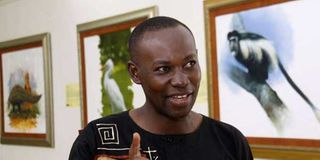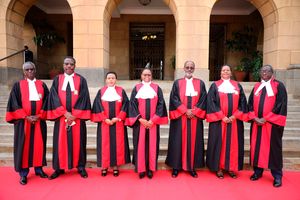Premium
How East African visual artists bleed to sell their works

Taga Nuwagaba with some of his paintings of animals, insects and plants depicting Buganda's totems in the background during the lunch of his book 'Me and My Totem' and exhibition at the Uganda Museum in 2010. PHOTO | MORGAN MBABAZI | NATION MEDIA GROUP
Visual artists in East Africa have to contend with a poor arts infrastructure, lack of arts publishing and arts criticism, copycats, erratic power supply and poor telecommunications, and dependence on expatriates to buy their work, among other challenges.
For these reasons, a study titled ‘Scoping the Visual Arts Scene in East Africa’ conducted by the Tom Fleming Creative Consultancy, based in the UK, concludes that “contributions from the East African region are missing in the increasingly globalised intellectual discourse and art scene.”
According to the report, the lack of higher education in the visual arts is a continuing challenge for the region. There are distinct groups of artists: Those who are established and working internationally, and who will often have received a higher education in the visual arts abroad, and those who have had little or no opportunity for formal education or training and little exposure beyond their immediate area. Many artists are self-taught and learn from their peers.
Philip Kwesiga, a distinguished designer of ceramics based in Kampala, partly blames the limited art education in Uganda on the general attitude of the citizens and education policy makers towards the arts.
“…We are so much obsessed with science and technology not knowing that the other developed models we are using are hinged on the arts and culture.
That is why we have architecture that is not informed by the arts and culture, we have dresses that are foreign, we use objects and products that are strange to our culture. Indeed we have to unlearn in order to use some of the world products/objects we have tended to adopt…,” Kwesiga told the Saturday Nation.
According to the report, the lack of educational opportunities, a poor arts infrastructure that limits the provision of, and access to, museum collections and exhibition spaces for modern and contemporary art, the scarcity of arts publishing and arts criticism combine to create a climate in which artists often need to make work that sells, in order to survive.
The study that was commissioned by the British Council in October 2013 comprised preparatory desk research and interviews in London, and research visits to Kenya, Uganda, Rwanda, Ethiopia, and Tanzania with a variety of stakeholders taking part.
Nuwa Wamala Nyanzi, a self-taught artist based in Kampala, told Saturday Nation: “Most practicing artists are not formally taught because to them art is a natural calling. …They are less encumbered with structured and regimental thinking associated with academia.”
There seems to be a reluctance to critique work and limited understanding, among artists and audiences, of how to receive and engage with work, the report released by the British Council in Nairobi, Kenya last year, adds. “Lack of arts criticism in particular inhibits artistic critical debate,” it notes.
While acknowledging limited art criticism in the region, Kwesiga, a fine art professor at Makerere University in Kampala, observes that there are also limited platforms or spaces where artists can express or carry out discourse in their own and other art practices. “…Art criticism also follows the contemporariness of certain art movements of the time as compared to the past art movements — of which most Ugandan artists are not sure about.”
“In addition, a good section of the artists are self-trained and have less command of such movements and histories. Such artists cannot make any meaningful and sustained criticism. Our public also has issues with the arts and the artists that produce it. …Our people don’t know that art(s) is the kingpin of development. That is why they pay less attention to this rather noble profession,” Kwesiga adds.
Kwesiga works on transformation and improvement of local material culture (artifacts) especially pottery/ceramics. He has exhibited his works in Kampala and around the world. He works as a graphic designer and illustrates children’s books.
An established expat scene, created partly by the NGOs, makes for a transient population and often an uninformed art audience in Uganda. Along with tourists, these groups form most of the art-buying public. “Encouraging and educating a local indigenous audience is a high priority,” the report suggests.
According to Kwesiga, visual arts consumption is considered by most Ugandans as a luxury, adding: “…The way we present our visual arts has a lot to be desired. The quality of materials and surfaces are still an issue. Art materials are very hard to come by, thereby pushing some artists to use alternative choices.”
Nyanzi differs: “There is a perception of the foreigners, especially those from the western world, as being the main buyers of art here in Uganda. On the contrary, my art is mostly bought by Ugandans because they do identify with it. That doesn’t mean foreigners don’t buy my art. They do, especially those with feelings.”
“The art that usually catches the eye of the western world is that which is produced with a Eurocentric target in mind. The majority of artists who produce such work are themselves products of the Eurocentric education system,” Nyanzi adds.
Nyanzi’s works of art are in batik, pastel, acrylic, oil and water colours which are earthy, vibrant and reflective of the African culture and environment. He has held exhibitions and slide\talk presentations across the world.
The main income streams for artists in East Africa are through selling work, some working on public or private commission with some undertaking large-scale, sculptural pieces or murals for the public realm. Working in a ‘breadline context,’ some artists in Tanzania will only take part in professional development opportunities if they are paid to do so.
The report suggests that NGOs can provide lucrative work for artists, as part of their advertising campaigns in illustration and the graphic arts.
As elsewhere in East Africa, the economics of selling in Uganda are often bound up with not being able to get a job that pays, artists copying each other because of popular themes and styles, and the buying habits of the arts audiences.
Nyanzi says that copying of fast selling themes and styles can be found in all professions, and that is why there are laws to deal with intellectual property rights.
“However, it is a vice that should be discouraged because it hampers creativity and undermines the value and status of the original work and the author who may be unfairly accused of overcharging,” he argues.
The study notes that with reliance on an art audience or market that is mainly uneducated in viewing and understanding contemporary visual arts, there is a reluctance to deviate from what is known and saleable.
Communication is a significant challenge in the region with erratic power supply and telecommunications contributing to the exasperation. Overburdened traffic systems, congestion and many unpaved roads and pot-holes make daily working a challenge and influence the scheduling of events, impacting on punctuality and timing.
Most funding of the arts comes mainly from government, charitable and private sources outside Africa, with Europe as main source.
The research identified six areas that would benefit from development and investment: professional skills; practical mentoring; artistic exchange and collaboration; new ways of showcasing work; research; and audience development.




